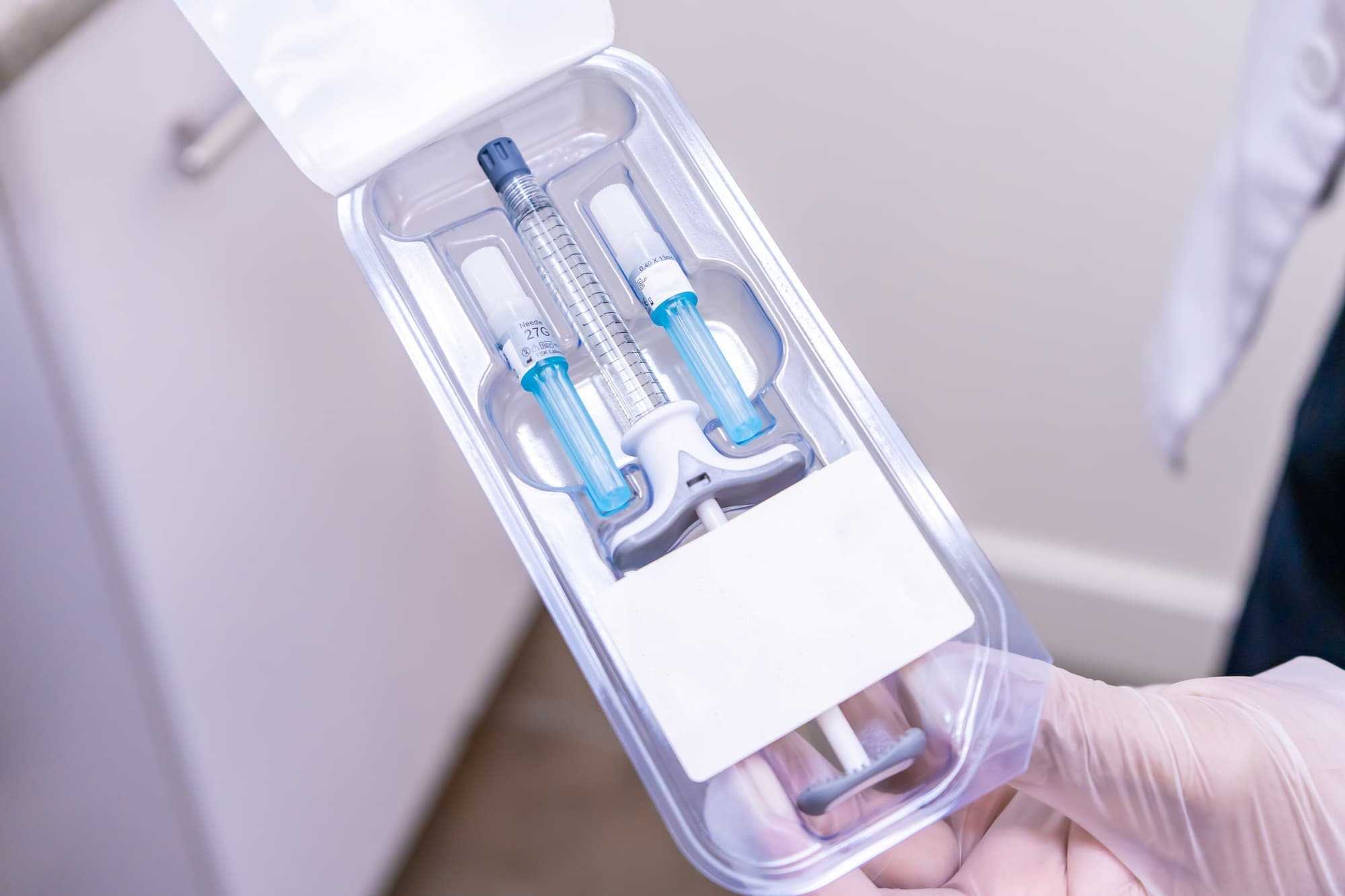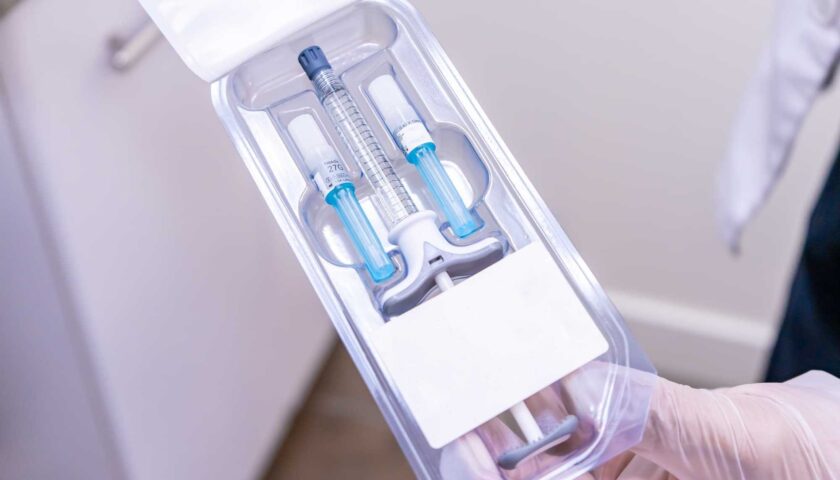
Both Bellafill, previously known as Artefill and Juvederm, are well-known dermal filler brands used for facial rejuvenation treatments. Both diminish facial wrinkles and other fine lines, improve skin elasticity, and address loss of volume. At a quick glance, it can appear that we’re talking about the same product, but you and your patients should know the key differences before deciding which is the right choice. Today we will pit Bellafill vs. Juvederm and examine their unique characteristics.
What Is Bellafill?
Bellafill is the only FDA-approved permanent dermal filler that consists of a bovine collagen solution and polymethylmethacrylate (PMMA). The ratio of PMMA to bovine collagen is around 20:80. When applied, the bovine collagen provides immediate results, but over time, it’s absorbed, and natural collagen production is stimulated. The PMMA, which are tiny balls of purified thermoplastic, remains forever and provides structural support.
These PMMA balls are the permanent part of the filler, and the only way to remove them is surgically. This would only be required if the filler had settled incorrectly or if the patient wanted to remove it because they didn’t like the results. Patients who are new to dermal fillers should consider starting with a temporary filler like Juvederm before opting for a permanent one. This is one of the essential differences between Bellafill and Juvederm. One isn’t fully degradable, while the other is fully biodegradable.
The Bellafill filler lasts up to five years and excels at treating certain types of acne scars. It is used off-brand to treat wrinkles and fine lines, correct facial contours, and improve the skin’s overall appearance.
What Is Juvederm?
Juvederm is also an FDA-approved dermal filler, but unlike Bellafill, it’s a temporary filler created from hyaluronic acid (HA). They are fully biocompatible and biodigestible. But while this is one of the advantages, it’s also one of the main disadvantages compared to permanent fillers. The Juvederm filler can last between nine and eighteen months, depending on the type of Juvederm product used, while permanent fillers last up to five years.
One of the primary benefits of Juvederm over Bellafill is its ease of removal by injecting hyaluronidase enzyme, which breaks down HA and allows the body to safely absorb it. Even without introducing hyaluronidase enzymes, the body slowly metabolizes the HA until nothing is left.
When applied, the Juvederm filler compliments the patient’s natural supply of HA that has diminished over time, resulting in fresher skin and restoring volume and elasticity to the applied area, bringing noticeable results quickly.
Bellafill vs. Juvederm: Key Differences
There are six notable differences between these two dermal fillers. Those are:
- Treatment Area: Bellafill is primarily used for treating deep wrinkles and acne scars, while Juvederm is versatile and can be used for various areas, including lips, cheeks, and nasolabial folds.
- Duration: Bellafill is a permanent dermal filler that lasts up to five years, while Juvederm is a temporary filler that lasts between nine and eighteen months.
- Composition: Bellafill consists of a bovine collagen solution and PMMA, while Juvederm is composed of HA. Both Bellafill and Juvederm have small amounts of lidocaine to ease discomfort, but the treatment may still require topical cream for more sensitive patients.
- Reversibility: While Juvederm can be easily reversed by injecting hyaluronidase enzymes to break down the hyaluronic acid, Bellafill would require a surgical procedure to be completely removed.
- Cost: Due to its permanent nature, Bellafill generally has a higher upfront cost than Juvederm, but it’s cheaper in the long run. Juvederm is initially cheaper but requires frequent maintenance treatments.
- Skin Testing: Bellafill requires a pre-treatment skin test to ensure the patient is not hypersensitive to bovine collagen. On the other hand, Juvederm does not necessitate an allergy test, as it uses hyaluronic acid, which is naturally found in the body.
Now that we know the differences, it’s time to look at the benefits of each filler.
Benefits of Bellafill
While they look similar, there are key benefits to using one over the other. For Bellafill, those benefits are:
Long-lasting results: As a permanent dermal filler, Bellafill provides long-lasting improvement. The results can stay for years, reducing the need for frequent touch-ups like you have with temporary fillers.
Stimulates collagen production: Bellafill not only provides immediate volume but also stimulates the production of collagen over time. This collagen stimulation leads to continued improvement in skin texture, elasticity, and overall skin quality.
FDA-approved treatments: Both Bellafill and Juvederm are FDA-approved, but Bellafill is approved for treating nasolabial folds and moderate to severe acne scars. When it comes to off-label use, it’s used for lipstick lines, to fill in deep scars, for nose and jaw re-sculpturing, and to restore the facial volume lost due to aging.
Reduced need for maintenance: Bellafill requires fewer maintenance treatments than temporary fillers like Juvederm due to its permanent nature. This can save patients time and potentially reduce long-term costs associated with more frequent touch-ups.
Patient satisfaction: In a four-year clinical trial with 212 patients, many patients reported high levels of satisfaction, ranging from 83.3% to 99%. It is important to note that the patients underwent treatment for various concerns, including acne scars, malar volume restoration, chin augmentations, nasolabial fold augmentations, volume restorations, lip augmentations, and jaw re-sculpturing.
Benefits of Juvederm
Before we get to Juvederm benefits, it should be noted that both brands share several common advantages. They are both non-invasive, give natural-looking results, have a relatively short treatment duration (typically ranging from 15 to 60 minutes, depending on the extent of the procedure), and don’t require post-treatment downtime.
Duration: While Bellafill is a permanent filler lasting up to five years, Juvederm provides temporary results that typically last between 9 and 18 months. This duration may be preferable for patients seeking more flexibility or who are uncertain about committing to long-lasting results.
FDA-approved treatments: Juvederm offers a wide range of products specifically formulated to target different areas of the face, including under-eye hollows, wrinkles and folds, lips, perioral rhytids, lip augmentation, and cheek volume loss. All of these are FDA-approved. This variety allows for tailored treatments based on individual patient’s needs and desired outcomes.
Reversibility: One of the significant advantages when comparing Juvederm vs. Bellafill is Juvederm’s reversibility. It can be easily achieved by injecting hyaluronidase enzymes. This allows for adjustments or complete removal if desired, providing greater patient flexibility.
Cost considerations: Juvederm generally has a lower upfront cost compared to Bellafill. This can make it a more accessible option for patients who are budget-conscious or have shorter-term goals.
Side Effects of Bellafill
Like any medical product, Bellafill fillers are not without potential side effects. These side effects may include:
- Swelling
- Bruising
- Rash
- Redness
- Itching
- Discoloration
- Asymmetry
- Infection
- Granulomas
Most of the side effects will pass within a week, but in some rare instances, they can last several months. It should be noted that Granulomas don’t pass, but they are extremely rare.
Side Effects of Juvederm
Just like they share some benefits, Juvederm and Bellafill also share some side effects common to them and to other fillers on the market. The most common Juvederm side effects include:
- Swelling
- Bruising
- Rash
- Redness
- Itching
- Discoloration
- Lumps
- Infection
To minimize the risk of potential side effects, patients should take certain precautions following the procedure. Within the first 24 to 48 hours, they should refrain from consuming alcohol, smoking, excessive sun exposure, accidentally pressing or sleeping on the treated area, and vigorous physical activities. These recommendations apply to both Juvederm and Bellafill products.
Conclusion
To meet the diverse needs of their patients, doctors and other skilled medical professionals must provide a wide range of treatment options. Both products are FDA-approved and deliver exceptional outcomes that are immediately visible. These fillers can be utilized individually or in conjunction with other invasive or non-invasive treatments to achieve optimal results. When choosing between Bellafill or Juvederm, it is crucial to consider factors such as patient preferences, medical history, and desired duration of effects.
FAQ
What happens after five years with Bellafill?
Over time, the effects of the treatment may gradually diminish as natural collagen production resumes while the PMMA beads of Bellafill remain in place. To maintain the desired benefits, additional treatments may be necessary.
Which is better, Juvederm or Bellafill?
Both fillers deliver fantastic results, but the most significant difference lies in the duration of those results. If the patient is seeking long-term benefits, Bellafill is the logical choice. However, for individuals undergoing their first filler treatment, Juvederm is a better option, as it offers a temporary solution and allows them to assess their response and satisfaction before considering a more permanent filler like Bellafill.
What are the disadvantages of Bellafill?
The primary drawback of Bellafill is its non-reversible nature, as the polymethylmethacrylate (PMMA) beads cannot be removed without surgical intervention.
References:
- ArteFill: a permanent skin filler; Kevin W Broder and Steven R Cohen; May 2006
- Hyaluronidase: An overview of its properties, applications, and side effects; Hyunwook Jung; Jul 2020
- The use of polymethyl-methacrylate (Artecoll) as an adjunct to facial reconstruction; David Mok (BSc) and Jorge Schwarz (BSc, MD, FRCS(C), FACS); 2004
- Facial Soft Tissue Augmentation With Bellafill: A Review of 4 Years of Clinical Experience in 212 Patients; Philip Solomon, Chew Lip Ng, Jaimie Kerzner, and Richard Rival; May 2021
- Optimizing outcomes with polymethylmethacrylate fillers; Michael H Gold and Neil S Sadick; Mar 2018
- Polymethylmethacrylate Collagen Gel-Injectable Dermal Filler for Full Face Atrophic Acne Scar Correction; John H Joseph, Ava Shamban, Laura Eaton, Alayne Lehman, Steven Cohen, James Spencer, Suzanne Bruce, Pearl Grimes, Ruth Tedaldi, Valerie Callender, and Phillip Werschler; Dec 2019
Injectable aesthetics are popular due to their ability to provide noticeable results with minimal downtime compared to surgical procedures. They are versatile and can be tailored to meet individual aesthetic goals, whether it's enhancing lips, restoring facial volume, or smoothing out wrinkles. However, they should always be administered by qualified professionals to ensure safety and achieve optimal results.
Injectable aesthetics are used to enhance facial features, reduce the signs of aging, and improve overall facial symmetry and appearance.
Key types of injectable aesthetics include:
-
Dermal Fillers: These injectables are used to add volume, fill in wrinkles and folds, and enhance facial contours. They often contain substances like hyaluronic acid, collagen, or calcium hydroxylapatite, which help plump up the skin and smooth out fine lines and wrinkles.
-
Botulinum Toxin (Botox): Botulinum toxin injections temporarily relax facial muscles that cause wrinkles and lines to form. It is commonly used to treat forehead lines, frown lines between the eyebrows, and crow's feet around the eyes.
-
Collagen Stimulators: These injectables stimulate the body's own collagen production, helping to improve skin texture and firmness over time. Examples include poly-L-lactic acid (Sculptra) and calcium hydroxylapatite (Radiesse).
-
Neurotoxin Injections: Besides Botox, other neurotoxins such as Dysport and Xeomin are used similarly to reduce wrinkles and lines.





